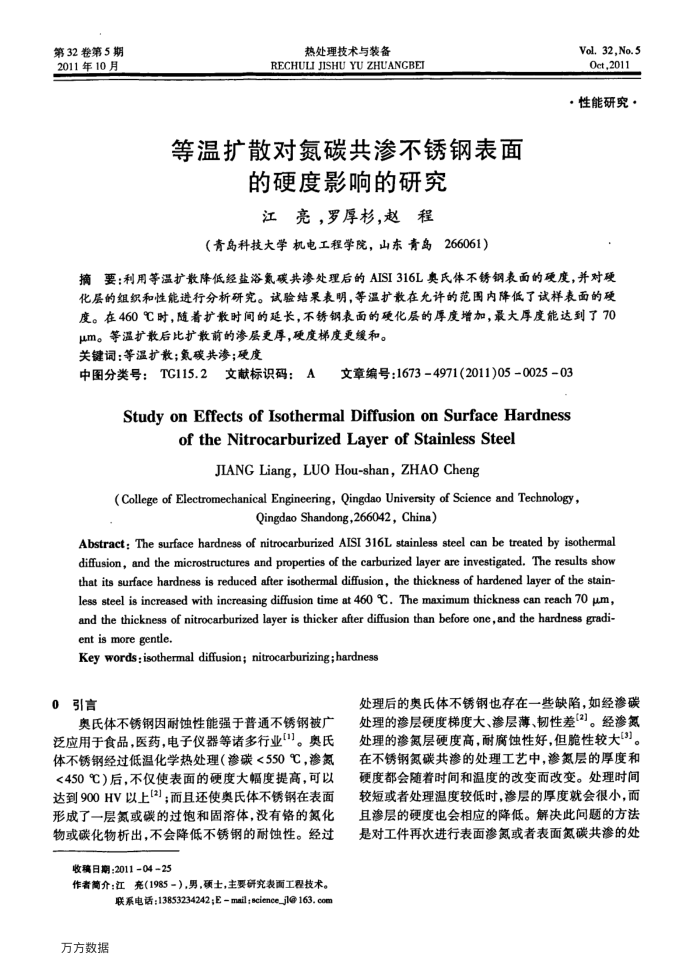等温扩散对氮碳共渗不锈钢表面的硬度影响的研究
内容简介
 第32卷第5期 2011年10月
第32卷第5期 2011年10月热处理技术与装备
RECHULI JISHU YU ZHUANGBEI
等温扩散对氮碳共渗不锈钢表面
的硬度影响的研究江亮,罗厚杉,赵程
(青岛科技大学机电工程学院,山东青岛266061)
Vol.32,No.5 Oct,2011
·性能研究·
摘要:利用等温扩散降低经盐浴氮碳共渗处理后的AISI316L奥氏体不锈钢表面的硬度,并对硬化层的组织和性能进行分析研究。试验结果表明,等温扩散在允许的范图内降低了试样表面的硬度。在460℃时,随着扩散时间的延长,不锈钢表面的硬化层的厚度增加,最大厚度能达到了70
μm。等温扩散后比扩散前的渗层更厚,硬度梯度更缓和。关键词:等温扩散;氧碳共渗:硬度
文章编号:1673-4971(2011)05002503
中图分类号:TC115.2文献标识码:A
StudyonEffectsofIsothermalDiffusiononSurfaceHardness
oftheNitrocarburizedLayerofStainlessSteel
JIANG Liang, LUO Hou-shan, ZHAO Cheng
(College of Electromechanical Engineering,Qingdao University of Science and Technology,
Qingdao Shandong,266042,China)
Abstract: The surface hardness of nitrocarburized AISI 316L stainless steel can be treated by isothermal diffusion, and the microstructures and properties of the carburized layer are investigated. The results show that its surface hardness is reduced after isothermal diffusion, the thickness of hardened layer of the stain less steel is increased with increasing diffusion time at 460 C.Themaximum thickness can reach 70 μm, and the thickness of nitrocarburized layer is thicker after diffusion than before one,and the hardness gradi-ent is more gentle.
Keywords:isothermal diffusion; nitrocarburizing;hardness
0引言
奥氏体不锈钢因耐蚀性能强于普通不锈钢被广泛应用于食品,医药,电子仪器等诸多行业("。奥氏体不锈钢经过低温化学热处理(渗碳<550℃,渗氮 <450℃)后,不仅使表面的硬度大幅度提高,可以达到900HV以上[3];而且还使奥氏体不锈钢在表面形成了一层氮或碳的过饱和固溶体,没有铬的氮化物或碳化物析出,不会降低不锈钢的耐蚀性。经过
收稿日期:2011-04-25
作者简介:江亮(1985-),男,硕士,主要研究表面工程技术。
联系电话:13853234242;Email;science_jl@163.com
万方数据
处理后的奥氏体不锈钢也存在一些缺陷,如经渗碳处理的渗层硬度梯度大、渗层薄、韧性差(2]。经渗氮处理的渗氮层硬度高,耐腐蚀性好,但脆性较大[3]。在不锈钢氮碳共渗的处理工艺中,渗氮层的厚度和硬度都会随着时间和温度的改变而改变。处理时间较短或者处理温度较低时,渗层的厚度就会很小,而且渗层的硬度也会相应的降低。解决此问题的方法是对工件再次进行表面渗氮或者表面氮碳共渗的处
上一章:钢纤维D41D008氧化铁皮结构与厚度的优化
下一章:热处理厂常见的一些问题